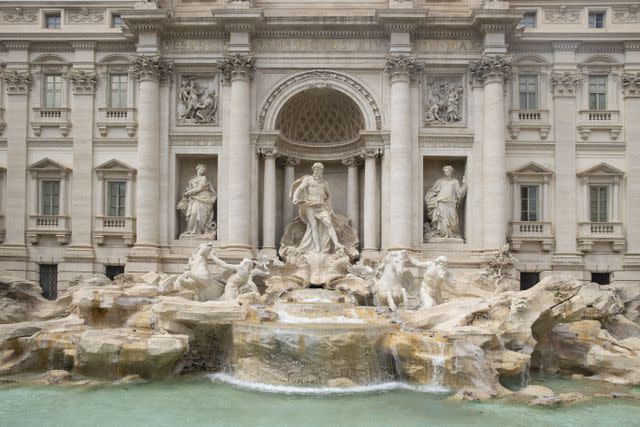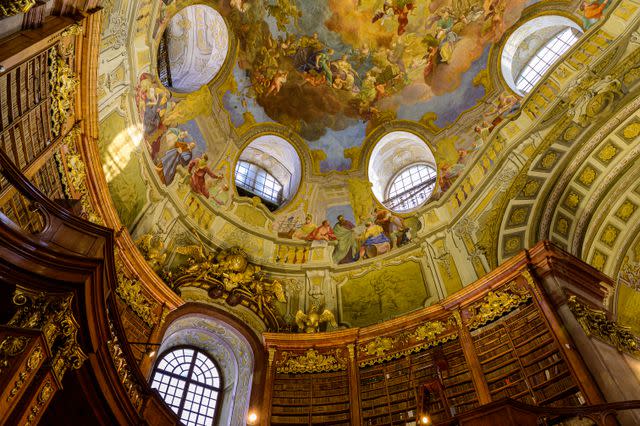Baroque Architecture: History, Key Characteristics, and Iconic Buildings
Here's everything you need to know about this over-the-top architecture style.
:max_bytes(150000):strip_icc():format(jpeg)/GettyImages-1228246698-13e80c1666184826a772bd28218f9d5d.jpg)
Getty Images / NurPhoto
If you look up the word baroque, the synonyms ‘ornate’ and ‘extravagant’ are always close by. Indeed, the Baroque architectural style is recognized by its grand scale, elaborate facades, and lavish interiors. Lasting for 150 years, the Baroque period of architecture, music, and art influenced churches, palaces, mansions, and civic structures across the globe. Examples of Baroque architecture include well-known tourist destinations such as the Trevi Fountain in Rome, the Winter Palace in Saint Petersburg, and many portions of Mexico City’s Metropolitan Cathedral.
More than 400 years after its inception, French Baroque was among the top 10 trending Google searches for architectural styles in the U.S. in 2023. Discover the history and signature design elements behind the opulent style that’s seeing renewed interest, and get to know some of the iconic Baroque buildings around the world.

Getty Images / Steve Christo - Corbis
A History of Baroque Architecture
Emerging in Italy during the late 16th century, the Baroque style of architecture was part of the Catholic Church’s strategy to bring people back to their religion. “Baroque architecture emerged as a backlash to the simplicity and austerity of the Protestant Reformation, and so its design is characterized by theatricality that was meant to elicit awe, surprise, and emotion in its users and viewers,” says Kate Reggev, a New York City-based architect and historian.
Many of the characteristics of the Baroque style, like statues and frescoes, originated with religious figures and scenes of the Catholic faith but evolved to include Greek and Roman gods and even contemporary people. For example, the ceiling of the Hall of Mirrors at Versailles depicts the early reign of King Louis XIV.
Like the spread of religion, Baroque architecture expanded around the globe: prominent in Europe, it even made its way to Latin America, remaining a dominant architectural style into the 18th century. According to Reggev, Baroque style did not establish itself in the same way in the United States “aside from areas that were colonized by Spain, like The Alamo.” Instead, Reggev says much of the Baroque architecture in the U.S. developed during the Baroque Revival, around the turn of the 20th century.
You’ll often see Baroque architectural styles identified by location (such as Italian or French Baroque) or by time period (like early and late Baroque), but the two differentiations are actually closely connected. According to Reggev, Early Baroque is also often Italian Baroque, because that’s where the style developed. “High Baroque can be found throughout much of Europe as the style spread throughout the continent, and by Late Baroque it was dissipated across the globe as far as the Latin American colonies, Russia, and the Ottoman Empire in the Middle East,” says Reggev.
Is it necessary to understand these versions in order to recognize Baroque style? Not exactly. Reggev says the variations are important to know, but the differences “can get pretty down to the details and really specific.” For example, in addition to possibly indicating time period, geographic identifiers often allude to additional characteristics of the style, like Moorish influences in Spanish Baroque or the symmetry of French Baroque. You’ll likely be able to identify Baroque architecture, regardless of the period or location, based on the architectural features characteristic throughout the Baroque era, highlighted below.
Related: Neoclassical Interior Design Is Timeless and Traditional: Get the Look

Getty Images / Stefan Cristian Cioata
Key Design Elements of Baroque Architecture
Often built of stone, all Baroque structures are grand in scale, dimension, and detail. They incorporate domes, towers, and cupolas, creating a dramatic exterior profile. The pronounced form is further enhanced by decorative architectural elements. St. Paul’s Cathedral in London is a good example, though it’s somewhat more subdued in its ornamentation (like most of the English Baroque variants). Inside, Baroque structures offer the same attention to dimension and detail. The results are towering, grandiose, and awe-inspiring creations that invite the viewer to look up, whether inside or outside.
Curves and Movement
According to Reggev, “dramatic forms and flourishes” and “visual activity and movement” are some of the definitive features of Baroque architecture. Curves play a prominent part in both of those characteristics. On a large scale, rounded exterior elements like domes and niches stand out against the common vertical and horizontal lines of Baroque buildings. Inside you’ll find curved walls, archways, ceilings, and oval-shaped spaces.
Movement comes into Baroque architecture through decorative architectural elements. Reggev makes specific note of Solomonic columns, which appear to swirl or twist like a corkscrew. Solomonic columns can be found on exteriors, like the St. Anthony Cathedral in Huancavelica, Peru, but they’re also common in interiors. The Baldacchino, the large bronze canopy over the high altar inside St. Peter’s Basilica, is an iconic example. An abundance of scrolls, sweeping foliage, and curved moldings, as well as depictions of typically moving objects, such as clouds and winged figures like cherubs, also add movement.
For a sense of curves and movement in Baroque architecture, take a virtual walk through the State Hall of the Austrian National Library. The space includes a painted cupola, an oval room, an undulating balcony and railings along the second level, curved ceilings and windows, and rounded columns.
Ornate Facades
The facades of Baroque buildings incorporate a number of decorative elements that are highly detailed, including cartouches, pediments, niches, columns and pilasters, balusters, and cornices.
Statues and figures are also commonly added to the structures, presented in niches, positioned above rooflines, or even integrated into the building, or placed like colonnades around the building and surrounding grounds.
The facade of St. Peter’s Bascillica and the adjacent piazza, St. Peter’s Square, offers some of the most iconic Baroque architecture and includes many, if not all, of the elements listed here. The facade was the work of Carlo Maderno, and Gian Lorenzo Bernini created the square. These two architects were integral to the development of the Baroque style.
Illustrative, Colorful Painting
Baroque buildings notably incorporated color, significantly through painted frescoes and murals on both walls and ceilings. Reggev makes special note of two characteristic treatments that create visual illusions in Baroque architecture: the trompe-l’oeil and quadratura.
A French term that translates to “trick the eye”, Reggev explains trompe-l’oeil as “the artistic practice of making highly realistic optical illusions of three-dimensional objects and spaces on a two-dimensional surface, like painting decorative moldings on a flat surface.” Another example is painting windows where there were none, offering the illusion of light and outdoor views.
The second technique, quadratura, relates to “ceilings painted to look like the sky, to give the illusion of looking directly up at the heavens,” says Reggev. The subjects of these paintings are grand in scale and nature, not only decorating massive surfaces or even entire rooms but also depicting larger-than-life people and events.
Austria’s Admont Abbey library is one Baroque space you may recognize from social media thanks to its photogenic, almost fairytale-like feeling. It features seven ceiling frescoes created by Bartolomeo Altomonte in his 80s and depicts themes of knowledge and enlightenment.
Luxe Interiors
Ornamentation is amplified in Baroque interiors. In addition to domes and cupolas, vaulted ceilings consist of multiple levels and visual detailing. While heavenly paintings are one prominent characteristic of Baroque ceilings, prominent stuccos, geometric accents, and detailing like scrolls and flowers also increase the sense of dimension on ceilings.
Other architectural embellishments included carved molding and millwork found around doorways, archways, and ceilings, as well as an abundant use of columns. Highly decorated interiors included lavish finishing touches, particularly gilding but also plush fabrics, intricate tapestries, crystal, and chandeliers. Mirrors and windows were used as well, often to create an illusion of scale and drama. The Palace of Versailles is a renowned French Baroque structure known for its excess and decadence, particularly its interiors.
For more Better Homes & Gardens news, make sure to sign up for our newsletter!
Read the original article on Better Homes & Gardens.

